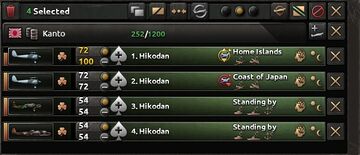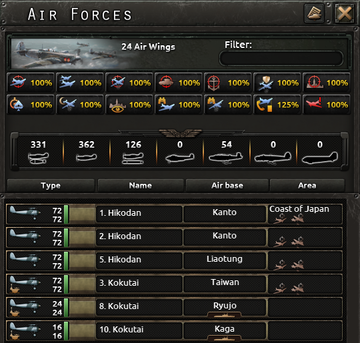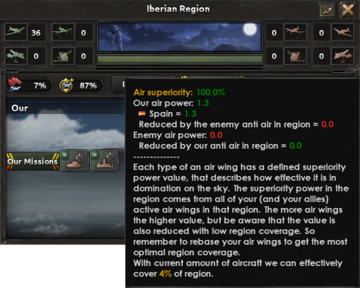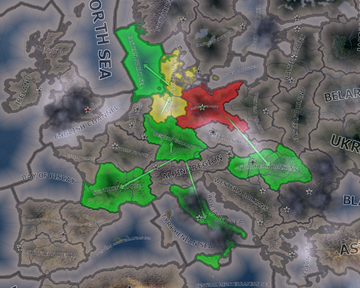(merge from offical wiki) |
Katyusha233(讨论 | 贡献) 小 (Katyusha233移动页面Air warfare至空战) |
(没有差异)
| |
2020年8月15日 (六) 21:50的版本
Air warfare consists of the deployment of air wings to strategic regions, where they can undertake missions targeting enemy air forces, land units, naval units or buildings. Given that air warfare is the only type that directly affects all three types of combat (on top of the strategic targeting), the air war is something the player must take into account when devising successful strategies.
Deployment
|
|
这部分内容可能已不适合当前版本,最后更新于1.9。 |
Air warfare is managed in the corresponding strategic air map mode. Most air operations work on the scale of strategic regions.
Air base
![]() Air bases are needed for the operation of aircraft. They are state-wide buildings, which may be constructed or repaired at the Construction screen. In contrast to other state-wide buildings, air bases are located in a specific province (which is fixed per state) and control of this province determines who can use the air base. When an air base gets captured, planes automatically relocate to other air bases if available and won't be lost.
Air bases are needed for the operation of aircraft. They are state-wide buildings, which may be constructed or repaired at the Construction screen. In contrast to other state-wide buildings, air bases are located in a specific province (which is fixed per state) and control of this province determines who can use the air base. When an air base gets captured, planes automatically relocate to other air bases if available and won't be lost.
Capacity
Each land-based air base can support 200 planes per base level without any penalties. The maximum air base level is 10, for a maximum of 2,000 aircraft. All types of planes may be located at these air bases, including carrier-capable models.
The capacity of an air base is shared between allies. The tooltip for the air base shows the total number of planes located there (and a list of the countries with air wings and the types of planes). If the total number of stationed planes exceeds the capacity, every additional percent of planes causes a 2% overcrowding penalty. At 50% over capacity, the penalty reaches 100%, so it is very important to manage the available capacity.
Air bases can be damaged by strategic bombing missions ![]() . Damage will reduce the capacity the base can hold until repaired.
. Damage will reduce the capacity the base can hold until repaired.
Carrier fleets
Aircraft carriers act as additional, floating air bases. Their capacity is determined by the deck size stat of the ship and they only support carrier-capable aircraft.
Normally aircraft on carriers only participate in naval battles, but carrier task forces on hold outside of ports can launch missions in a strategic area. This may be very useful to provide some air support for an amphibious invasion when other bases are out of range.
Air wing
Air wings are a group of planes forming an air unit attached to an air base. A new air wing is deployed from the air base screen. An air wing may be created only if there are sufficient planes and service manpower available.
The minimum size of an air wing is 1 plane, and the maximum size is 1,000 planes. It is possible to change the size of an existing air wing by clicking on an air base, then clicking on the top number on the left-hand side of the air wing's row.
All planes in an air wing must be of the same type; it is not possible to mix fighters with bombers, for example. However, different models of plane within the same type (e.g. 1936 fighters and 1940 fighters) may be mixed in the same air wing.
The reinforcement level of an air wing represents the amount of planes an air wing has at full strength. If the current number of planes is lower than the reinforcement level, new planes will be added to it as long as there are sufficient stockpiled planes of that type. If there are none, then reinforcement will take place when new planes of the correct equipment type are produced by military production lines.
Wings can be ![]() split or multiple wings of the same type
split or multiple wings of the same type ![]() merged into one in the air base view. There is also a Reorganize option
merged into one in the air base view. There is also a Reorganize option ![]() that allows greater control over moving planes between two or more wings of the same type.
that allows greater control over moving planes between two or more wings of the same type.
Once a new air wing is created, it will take several days for the planes to arrive at the air base. The wing may be assigned to an air region and given missions immediately, but it will not carry out the missions until the planes arrive.
If an air wing is disbanded, all of the planes will return to the equipment stockpile and will be available for deployment to other air wings.
Missions
- 主条目:Air missions
Air wings can be assigned to various missions.
Air combat
- 主条目:Air combat
Air superiority
|
|
这部分内容可能已不适合当前版本,最后更新于1.9。 |
Air superiority is the degree of dominance of your air force over an opponent's air force in a strategic region. Air superiority is provided by planes actively performing their mission and depends on their type as well. Each type of an air wing has a defined air superiority power value that describes how effective it is in domination of the sky (see table below).
| Aircraft Type | Superiority Power |
|---|---|
| Heavy Fighter | 1.25 |
| Fighter, Carrier Fighter, Jet Fighter, CAS, Carrier CAS, NAV, Carrier NAV, TAC, Jet TAC | 1.00 |
| Strategic Bomber, Jet Strategic Bomber | 0.01 |
Each air wing's air power is its number of planes, multiplied by the superiority power above and its mission efficiency.
A region's air superiority is determined by comparing your air power (plus allies) to the enemy's air power. This ratio is stated as a percentage and results in a color applied to a region (can be viewed using the Strategic Air map mode). The colors and interpretation of the colors is listed in the table below.
| Color | Air Superiority Percentage | Explanation |
| Red | < 40% | enemy has air superiority |
| Yellow | 40% - 60% | contested region |
| Green | > 60% | you (or allies) have air superiority |
Static AA ![]() can also reduce air superiority in an air region. Each building level (maximum level 5 per state) removes 5[1] air power from the opposing side.
can also reduce air superiority in an air region. Each building level (maximum level 5 per state) removes 5[1] air power from the opposing side.
Every 50 points of air superiority advantage in a strategic region gives a +1% air support penalty to enemy land combat defense and breakthrough. For this reason it is advised to hold air superiority as much as possible. AA inside divisions can reduce this penalty. Air superiority also inflicts a penalty to enemy movement.
Having air superiority in a sea region can increase the chance to spot enemy vessels [2] or to reduce enemy ship mission efficiency [3].
Air superiority can also affect other air missions such as:
- a port strike cannot be performed unless the enemy has less than 30% air superiority [4].
- a nuke cannot be dropped with a Strategic Bomber or Jet Strategic Bomber unless you have at least 75% air superiority [5].
- paratroopers cannot be dropped unless you have at least 70% air superiority [6].
Aces
|
|
这部分内容可能已不适合当前版本,最后更新于1.9。 |
Air combat has a chance of generating aces. An air wing may be assigned up to one ace only.
| Skill Level | Chance | Fighter Ace | Strategic Bomber Ace | CAS, TAC, or Naval Ace |
|---|---|---|---|---|
| "Good" | 0.9 |
|
|
|
| "Unique" | 0.4 |
|
|
|
| "Genius" | 0.05 |
|
|
|
The effects are scaled inversely by the size of the wing relative to 100 planes, to a maximum of 10x at 10 planes.
Strategy
|
|
这部分内容可能已不适合当前版本,最后更新于1.9。 |
Dealing with low mission efficiency
Deploying more planes can offset reduced mission efficiency to an extent, but basing planes closer to the center of the strategic region or using planes with longer range may be more efficient.
If the player does not control any bases within a region that they are attacking, then they are at a considerable disadvantage to their enemies, who do have control. The player might:
- Choose tactical bombers to carry out close air support missions, instead of CAS, and use heavy fighters because of their longer range.
- Try to capture an enemy air base as quickly as possible, so that the player can redeploy some fighters and CAS there. It might even be worthwhile if the player captures a state without an air base to build their own level 1 base there as quickly as possible. That will allow them to redeploy wings with up to 200 planes to be located within the region.
- Use strategic bombers to bomb enemy buildings, including air bases. This might cause enough damage to their air bases to "even the odds" by reducing enemy mission efficiency. But this may only work if their air bases are already close to full capacity.
- Using carrier fleets might also be very useful if the region has a coast where the player can (safely) anchor the fleet. Especially if the attack on the region is being carried out by a naval invasion. The carrier fleet can carry out the multiple roles of protecting the transport convoys, and providing shore bombardment.
- Abandon trying to compete for air superiority with the player's fighters, and rely only on interception missions. Fighters on interception missions only take off and attack bomber wings if they detect a target. This causes lower losses of the player's fighters. It will give the player's enemy the air superiority bonus in combat however.
| 政策 | 意识形态 • 阵营 • 国策 • 内阁 • 政府 • 傀儡国 • 外交 • 全球紧张度 • 内战 • 占领区 • 情报机构 |
| 生产 | 贸易 • 生产 • 建设 • 装备 • 燃料 |
| 科研与科技 | 科研 • 步兵科技 • 辅助部队(支援连)科技 • 装甲车辆科技 • 火炮科技 • 陆军学说 • 海军科技 • 海军学说 • 空军科技 • 空军学说 • 工程学科技 • 工业科技 |
| 军事与战争 | 战争 • 陆军单位 • 陆战 • 编制设计 • Army planner • 集团军 • 指挥官 • 作战计划 • 战术 • 海军单位 • 海战 • 空军单位 • 空战 • 经验 • 损耗与事故 • 后勤 • 人力 • 核弹 |
| 地图 | 地图 • 省份 • 地形 • 气候 • 地区 |
| 事件与决议 | 事件 • 决议 |
hoi4de:Air warfare hoi4es:Air warfare hoi4fr:Air warfare hoi4pl:Air warfare hoi4pt:Air warfare hoi4ru:Air warfare
- ↑ Defines NBuildings ANTI_AIR_SUPERIORITY_MULT = 5.0
- ↑ Defines NNavy DETECTION_CHANCE_MULT_AIR_SUPERIORITY_BONUS = 0.25
- ↑ Defines NNavy ENEMY_AIR_SUPERIORITY_IMPACT = -1
- ↑ Defines NAir PORT_STRIKE_ENEMY_SUPERIORITY_LIMIT = 0.3
- ↑ Defines NAir STRATEGIC_BOMBER_NUKE_AIR_SUPERIORITY = 0.75
- ↑ Defines NCountry PARADROP_AIR_SUPERIORITY_RATIO = 0.7




